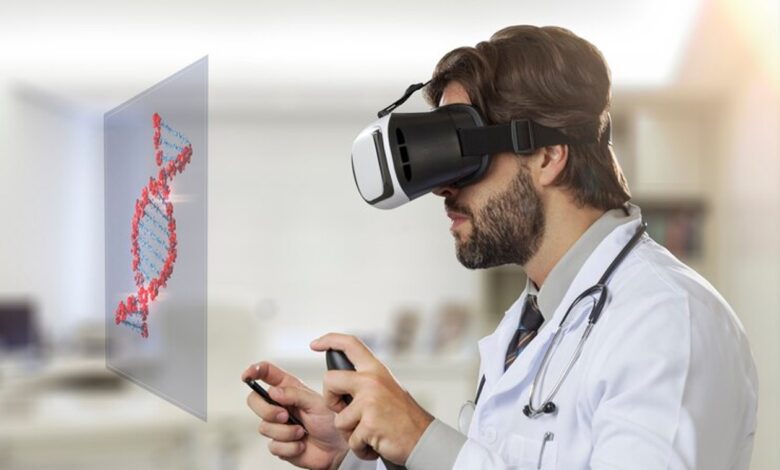Augmented Reality in Healthcare: The Future of Medicine

In recent years, Augmented Reality (AR) has transcended the realm of gaming and entertainment to make profound strides in healthcare. This innovative technology is poised to revolutionize the medical field, offering a plethora of benefits that range from enhanced patient care to improved medical training and research. In this comprehensive article, we will explore the fascinating world of Augmented Reality in healthcare, delving into its applications, advantages, challenges, and future prospects.
Augmented Reality, as the name suggests, involves enhancing our perception of reality by overlaying digital information onto the physical world. In the context of healthcare, this means merging computer-generated data with real-life medical scenarios. It opens up new dimensions in medical practice, research, and patient care.
Understanding the Basics of Augmented Reality
Augmented Reality, often abbreviated as AR, is a cutting-edge technology that blends the digital world with our physical surroundings. It enhances our perception of reality by overlaying computer-generated information, such as 3D models, data visualizations, or real-time content, onto the real world. In simpler terms, AR takes what we see and hear in the physical world and supplements it with additional digital elements.
Here’s a breakdown of the key components and concepts that form the foundation of Augmented Reality:
- Devices: AR is experienced through specialized devices like smart glasses, headsets, or even smartphone apps. These devices use cameras and sensors to capture the user’s surroundings and then superimpose digital elements onto the live view.
- Marker-Based and Markerless AR: AR applications can be classified into two main categories. Marker-based AR relies on specific visual markers or triggers, like QR codes, to initiate the augmented experience. Markerless AR, on the other hand, doesn’t require such markers and can recognize and augment objects or scenes without predefined triggers.
- Real-Time Interaction: AR is characterized by real-time interaction. Users can often interact with the augmented content, such as manipulating 3D objects, accessing additional information by tapping on virtual elements, or even playing interactive games overlaid on the real world.
- Spatial Mapping: AR devices often create a spatial map of the environment using sensors and cameras. This map is crucial for accurately placing digital elements within the physical space, ensuring that they align seamlessly.
- Head-Up Display (HUD): Many AR devices utilize a head-up display, where information is projected onto a transparent screen in front of the user’s eyes. This allows users to maintain their focus on the real world while accessing digital information.
- Applications: AR has a wide range of applications across industries. In addition to entertainment and gaming, it is extensively used in fields like healthcare, education, architecture, engineering, and more. Medical professionals, for instance, use AR to visualize complex anatomical structures during surgery, while students can explore interactive learning experiences.
- Augmented vs. Virtual Reality: It’s important to distinguish between Augmented Reality (AR) and Virtual Reality (VR). While AR enhances the real world with digital elements, VR immerses users in entirely virtual environments. VR devices typically cover the user’s field of vision, whereas AR devices allow users to see both the physical world and digital overlays simultaneously.
- Evolution and Future: AR technology continues to evolve rapidly. As devices become more compact, user-friendly, and affordable, AR is becoming more accessible to a broader audience. Integration with Artificial Intelligence (AI) is expected to enhance AR’s capabilities, making it even more valuable in various domains.
In summary, Augmented Reality is a groundbreaking technology that enriches our perception of reality by integrating digital information into the physical world. It has diverse applications and holds immense potential for transforming how we learn, work, and interact with our environment. As AR technology continues to advance, its impact on various industries, including healthcare, education, and entertainment, is poised to grow significantly.
Read More: The Ultimate Guide to Healthy Eating Habits for Weight Loss
AR in Medical Training and Education
One of the most promising applications of AR in healthcare is in medical training and education. Medical students and professionals can use AR to visualize complex anatomical structures, practice surgical procedures in a risk-free environment, and gain a deeper understanding of medical concepts.
Augmented Reality in Surgical Procedures
Imagine a surgeon wearing AR glasses that display critical patient information and real-time imaging during surgery. This level of precision can lead to safer surgeries and improved patient outcomes. AR is changing the way surgical procedures are conducted.
AR for Remote Consultations
Augmented Reality in Healthcare: In an era of telemedicine, AR bridges the physical gap between patients and healthcare providers. Through AR-powered telemedicine, doctors can diagnose and treat patients in real time, regardless of geographical boundaries.
Improving Patient Experiences with AR
Patients can benefit from AR too. Imagine a child in a hospital using AR to turn their room into a virtual adventure, easing their anxiety and making the hospital stay more comfortable. AR has the potential to enhance the overall patient experience.
Augmented Reality for Diagnosis and Treatment
Augmented Reality in Healthcare: In the diagnostic realm, AR aids in visualizing medical scans and data in 3D, allowing for more accurate diagnoses. Furthermore, AR can assist in guiding surgeons during complex procedures, minimizing risks and optimizing outcomes.
Overcoming Challenges in Implementing AR
While AR offers immense potential, it comes with its own set of challenges, including cost, integration into existing healthcare systems, and data security. Addressing these challenges is crucial for widespread adoption.
Privacy and Ethical Considerations
Augmented Reality in Healthcare: The integration of AR in healthcare raises important privacy and ethical questions. How can patient data be protected in an augmented reality environment? What are the ethical implications of AR-assisted surgeries? We’ll explore these concerns in this section.
The Future of Augmented Reality in Healthcare
The future of AR in healthcare is bright. As technology advances, we can expect more compact and user-friendly AR devices. Additionally, AI integration will enhance diagnostic capabilities, making healthcare even more efficient.
Augmented Reality and Telemedicine
Augmented Reality in Healthcare: As telemedicine continues to grow, AR will play a pivotal role in improving remote patient care. Real-time diagnostics and treatment recommendations will become standard practice.
AR and Patient Empowerment
Patients will have access to their medical data through AR interfaces, empowering them to actively participate in their healthcare decisions. Informed patients lead to better health outcomes.
AR-Enabled Medical Devices
Augmented Reality in Healthcare: Medical devices infused with AR technology will become commonplace. These devices will provide real-time health data and guidance, promoting preventive healthcare.
Healthcare Providers Embracing AR
Augmented Reality in Healthcare: Hospitals and healthcare facilities are recognizing the value of AR in improving patient care and operational efficiency. The adoption of AR will continue to rise.
Read More: 9 Surprising Health Benefits of Coffee
Conclusion
In conclusion, Augmented Reality in healthcare is not a distant dream but a rapidly advancing reality. Its potential to transform medical training, patient care, and diagnostic accuracy is nothing short of revolutionary. While challenges exist, the future of medicine looks brighter with AR as an integral part of it.
Augmented Reality is not just a glimpse into the future; it’s a transformative force that is reshaping the way we learn, work, and provide healthcare. With continued innovation and responsible implementation, AR promises to improve our lives and usher in a new era of possibilities. As we embrace this exciting journey, the potential for Augmented Reality is boundless.
FAQs
1. Is Augmented Reality safe for medical procedures?
Yes, when used responsibly and by trained professionals, AR enhances safety and precision in medical procedures.
2. Can patients access AR technology for personal healthcare?
Yes, as AR becomes more accessible, patients will have tools to monitor their health and collaborate with healthcare providers.
3. What are the main challenges in implementing AR in healthcare?
The main challenges include cost, integration into existing systems, and data security and privacy concerns.
4. How is AR expected to impact medical education?
AR is expected to revolutionize medical education by providing immersive and interactive learning experiences for students.
5. What role will AI play in the future of AR in healthcare?
AI will enhance AR’s diagnostic capabilities and make healthcare more efficient and data-driven.












2 Comments